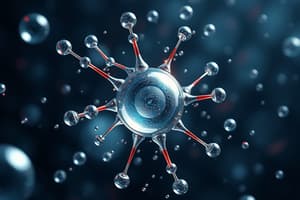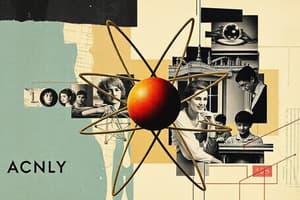Podcast
Questions and Answers
Which statement accurately describes the relationship between elements and atoms?
Which statement accurately describes the relationship between elements and atoms?
- Elements are formed when atoms combine in varying proportions, unlike compounds.
- Atoms are pure substances that cannot be broken down, while elements are the building blocks of matter.
- Elements consist of only one type of atom, and atoms are the smallest unit that retains the properties of an element. (correct)
- Atoms are organized in the periodic table, while elements represent chemical formulas.
Consider the following chemical reaction: $2H_2 + O_2 \rightarrow 2H_2O$. Which of the following statements correctly interprets this equation?
Consider the following chemical reaction: $2H_2 + O_2 \rightarrow 2H_2O$. Which of the following statements correctly interprets this equation?
- Two moles of hydrogen react with one mole of oxygen to produce two moles of water. (correct)
- Two grams of hydrogen react with one gram of oxygen to produce two grams of water.
- Equal volumes of hydrogen and oxygen combine to yield an equal volume of water.
- One molecule of hydrogen reacts with one molecule of oxygen to produce one molecule of water.
Why is it essential to balance chemical equations?
Why is it essential to balance chemical equations?
- To accurately represent the color changes during a reaction.
- To ensure the reaction proceeds at a reasonable rate.
- To indicate the reaction's equilibrium constant.
- To comply with the law of conservation of mass. (correct)
Which of the following is NOT a typical characteristic of a chemical reaction?
Which of the following is NOT a typical characteristic of a chemical reaction?
What distinguishes a compound from an element?
What distinguishes a compound from an element?
What information does a chemical formula provide about a compound?
What information does a chemical formula provide about a compound?
Which type of chemical formula provides the most detailed information about a molecule, including the arrangement of atoms and bonds?
Which type of chemical formula provides the most detailed information about a molecule, including the arrangement of atoms and bonds?
In a redox reaction, what process occurs?
In a redox reaction, what process occurs?
Consider the compound $C_6H_{12}O_6$. Which of the following statements is correct?
Consider the compound $C_6H_{12}O_6$. Which of the following statements is correct?
How do catalysts affect chemical reactions?
How do catalysts affect chemical reactions?
Flashcards
Chemistry
Chemistry
The study of matter, its properties, and how it changes.
Element
Element
A pure substance with only one type of atom.
Atom
Atom
The smallest unit of an element that retains its chemical properties.
Compound
Compound
Signup and view all the flashcards
Chemical Formula
Chemical Formula
Signup and view all the flashcards
Chemical Reaction
Chemical Reaction
Signup and view all the flashcards
Reactants
Reactants
Signup and view all the flashcards
Products
Products
Signup and view all the flashcards
Synthesis Reaction
Synthesis Reaction
Signup and view all the flashcards
Decomposition Reaction
Decomposition Reaction
Signup and view all the flashcards
Study Notes
- Chemistry is the study of matter and its properties as well as how matter changes
- It is a natural science that deals primarily with atoms and molecules
Elements
- An element is a pure substance consisting only of atoms with the same number of protons in their nuclei
- Elements cannot be broken down into simpler substances by chemical means
- Each element is defined by its unique atomic number, the number of protons in the nucleus of its atom
- Elements are organized in the periodic table based on their atomic number and chemical properties
- Elements are represented by chemical symbols, typically one or two letters long (e.g., H for hydrogen, O for oxygen, C for carbon)
- Examples include hydrogen (H), oxygen (O), gold (Au), and iron (Fe)
- Elements can exist as individual atoms or as molecules, where two or more atoms of the same element are bonded together (e.g., O2 is a molecule of oxygen)
Atoms
- An atom is matter's basic building block, consisting of a nucleus with protrons and neutrons, surrounded by electrons
- Atoms are the smallest unit of an element that retains the chemical properties of that element
- Protons are positively charged particles in the nucleus of an atom
- Neutrons are neutral particles in the nucleus of an atom
- Electrons are negatively charged particles orbiting the nucleus of an atom
- The number of protons in the nucleus determines the element to which an atom belongs
- Atoms are electrically neutral because they have the same number of protons and electrons
- Atoms can combine with other atoms to form molecules or compounds through chemical bonds
Compounds
- A compound is a substance formed when two or more elements are chemically bonded together in fixed proportions
- Compounds differ from elements in that they can be broken down into simpler substances by chemical means
- The properties of a compound are different from those of its constituent elements
- Compounds are represented by chemical formulas, indicating the type and number of atoms of each element
- Examples include water (H2O), carbon dioxide (CO2), and sodium chloride (NaCl)
- Compounds can be formed through ionic bonds, where electrons are transferred between atoms, or covalent bonds, where electrons are shared between atoms
- The bonding arrangement affects its properties
Chemical Formulae
- A chemical formula is a symbolic representation of a chemical compound that shows the types of elements and the number of atoms of each element in a molecule of the compound
- Chemical formulas use element symbols and subscripts to indicate the number of atoms of each element in the compound
- For example, H2O indicates that a molecule of water contains two hydrogen atoms and one oxygen atom
- The chemical formula of a compound can be determined experimentally through techniques such as elemental analysis and mass spectrometry
- Chemical formulas are used to write balanced chemical equations and to calculate the molar mass of compounds
- There are different types of chemical formulas, including empirical formulas, molecular formulas, and structural formulas
- An empirical formula represents the simplest whole-number ratio of atoms in a compound
- A molecular formula represents the actual number of atoms of each element in a molecule of the compound
- Structural formulas show the arrangement of atoms and chemical bonds in a molecule
Chemical Reactions
- A chemical reaction is a process that involves the rearrangement of atoms and molecules to form new substances
- Chemical reactions are accompanied by changes in energy, such as the release or absorption of heat
- Chemical reactions are represented by chemical equations, which show the reactants and products involved in the reaction
- Reactants are the starting materials in a chemical reaction
- Products are the substances formed as a result of a chemical reaction
- Chemical equations must be balanced, meaning that the number of atoms of each element must be the same on both sides of the equation
- Balancing chemical equations ensures that the law of conservation of mass is obeyed
- Chemical reactions can be classified into different types, such as synthesis, decomposition, displacement, and redox reactions
- Synthesis reactions involve the combination of two or more substances to form a single product
- Decomposition reactions involve the breakdown of a single compound into two or more simpler substances
- Displacement reactions involve the replacement of one element in a compound by another element
- Redox reactions involve the transfer of electrons between chemical species
- Chemical reactions are influenced by factors such as temperature, pressure, concentration, and the presence of catalysts
- Catalysts are substances that speed up a chemical reaction without being consumed in the process
Studying That Suits You
Use AI to generate personalized quizzes and flashcards to suit your learning preferences.
Description
Explore the fundamentals of chemistry with a focus on elements and atoms. Learn about the composition and properties of elements, their organization in the periodic table, and the structure of atoms. Essential concepts for grasping chemical interactions.




